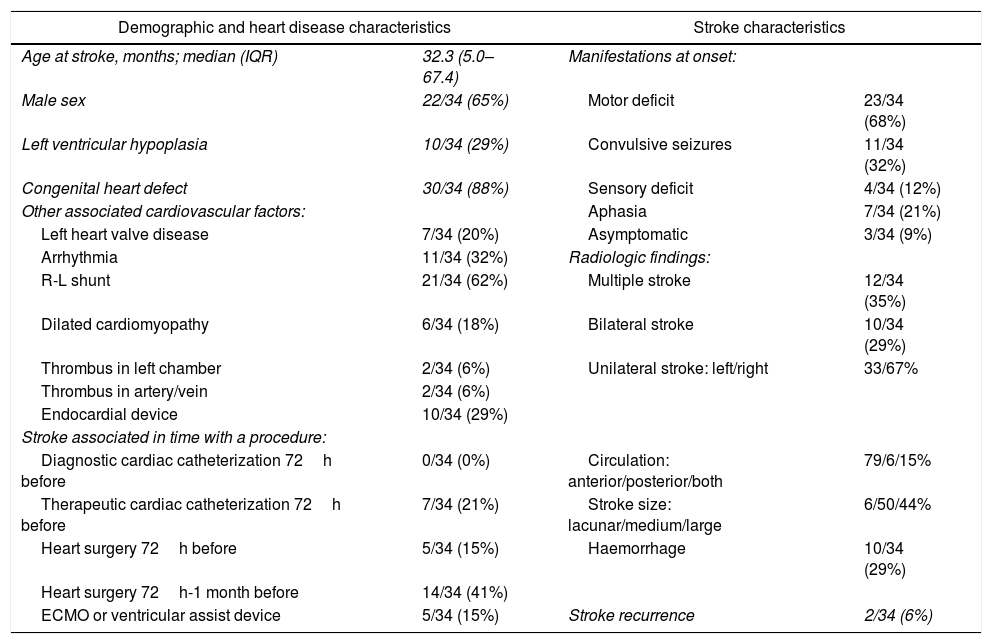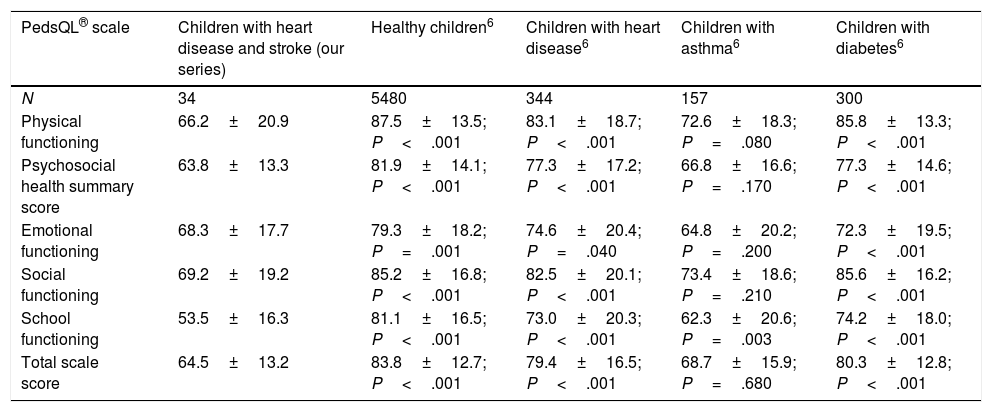Arterial ischaemic stroke is infrequent in the paediatric population. Between 50% and 80% of these patients develop sequelae that affect different areas.1 Heart disease is one of the most frequent causes of stroke in children and accounts for nearly one third of cases.2
The term health-related quality of life (HRQoL) refers to the impact of a disease and its treatment in the physical, psychological and social wellbeing of a patient as perceived by the patient. In recent years, there has been a growing interest in researching the quality of life of children that have experienced a stroke.3,4
Our objective was to assess HRQoL in a sample of children with heart disease who had suffered an arterial ischaemic stroke.
We recruited patients from a larger case series that analysed the outcomes of children with heart disease who had experienced an arterial ischaemic stroke between January 2000 and December 2014.5 Patient outcomes were evaluated by means of the Paediatric Stroke Outcome Measure (PSOM) and the modified Rankin scale (mRS) at least 6 months after the stroke. At the time, HRQoL in patients aged more than 5 years was assessed by means of the generic core scales of the Paediatric Quality of Life Inventory (PedsQL®) version 4, for which we obtained authorisation. The PedsQL® comprises 15 items, 5 on physical functioning, 4 on emotional functioning, 3 on social functioning and 3 on school functioning, in addition to a total scale score. The score can range between 0 and 100, with 0 representing the least quality of life and 100 the most.
In the statistical analysis of the data, we used the one-sample t test to compare the PedsQL® scores of our patients with those of healthy controls and children with other diseases reported in the reviewed literature.
Thirty-four children aged more than 5 years completed the quality of life questionnaire. Table 1 summarises the demographic characteristics of the patients, as well as the clinical features of their heart disease and stroke. The mean time elapsed between the stroke and the assessment was 6.9±4.1 years.
Characteristics of heart disease and stroke.
| Demographic and heart disease characteristics | Stroke characteristics | ||
|---|---|---|---|
| Age at stroke, months; median (IQR) | 32.3 (5.0–67.4) | Manifestations at onset: | |
| Male sex | 22/34 (65%) | Motor deficit | 23/34 (68%) |
| Left ventricular hypoplasia | 10/34 (29%) | Convulsive seizures | 11/34 (32%) |
| Congenital heart defect | 30/34 (88%) | Sensory deficit | 4/34 (12%) |
| Other associated cardiovascular factors: | Aphasia | 7/34 (21%) | |
| Left heart valve disease | 7/34 (20%) | Asymptomatic | 3/34 (9%) |
| Arrhythmia | 11/34 (32%) | Radiologic findings: | |
| R-L shunt | 21/34 (62%) | Multiple stroke | 12/34 (35%) |
| Dilated cardiomyopathy | 6/34 (18%) | Bilateral stroke | 10/34 (29%) |
| Thrombus in left chamber | 2/34 (6%) | Unilateral stroke: left/right | 33/67% |
| Thrombus in artery/vein | 2/34 (6%) | ||
| Endocardial device | 10/34 (29%) | ||
| Stroke associated in time with a procedure: | |||
| Diagnostic cardiac catheterization 72h before | 0/34 (0%) | Circulation: anterior/posterior/both | 79/6/15% |
| Therapeutic cardiac catheterization 72h before | 7/34 (21%) | Stroke size: lacunar/medium/large | 6/50/44% |
| Heart surgery 72h before | 5/34 (15%) | Haemorrhage | 10/34 (29%) |
| Heart surgery 72h-1 month before | 14/34 (41%) | ||
| ECMO or ventricular assist device | 5/34 (15%) | Stroke recurrence | 2/34 (6%) |
The PedsQL® total scale score was lower in patients that had poorer outcomes according to the PSOM (60.11±10.95 vs. 69.44±14.16; P=.038) and the mRS (52.50±7.32 vs. 66.10±13.09; P=.052), especially in the physical functioning subscale.
Patients with epilepsy had significantly lower scores in the physical functioning subscale of the PedsQL® (51.58±20.36 vs. 74.18±16.77; P=.001). We also found differences in the scores of patients with clinically significant hemiparesis in the physical functioning subscale (55.38±20.01 vs. 72.90±18.92; P=.015) and the total scale score of the PedsQL® (58.62±11.48 vs. 68.14±13.18; P=.039). Large size of the infarct was associated with significantly lower scores in the physical functioning PedsQL® (55.13±20.37 vs. 70.23±19.74; P=.04) due to greater motor deficits.
The scores in our patients were significantly lower than those of healthy controls reported in the literature6 (Table 2).
Quality of life scale scores (PedsQL®) in our patients compared to those of healthy children and children with other chronic diseases.
| PedsQL® scale | Children with heart disease and stroke (our series) | Healthy children6 | Children with heart disease6 | Children with asthma6 | Children with diabetes6 |
|---|---|---|---|---|---|
| N | 34 | 5480 | 344 | 157 | 300 |
| Physical functioning | 66.2±20.9 | 87.5±13.5; P<.001 | 83.1±18.7; P<.001 | 72.6±18.3; P=.080 | 85.8±13.3; P<.001 |
| Psychosocial health summary score | 63.8±13.3 | 81.9±14.1; P<.001 | 77.3±17.2; P<.001 | 66.8±16.6; P=.170 | 77.3±14.6; P<.001 |
| Emotional functioning | 68.3±17.7 | 79.3±18.2; P=.001 | 74.6±20.4; P=.040 | 64.8±20.2; P=.200 | 72.3±19.5; P<.001 |
| Social functioning | 69.2±19.2 | 85.2±16.8; P<.001 | 82.5±20.1; P<.001 | 73.4±18.6; P=.210 | 85.6±16.2; P<.001 |
| School functioning | 53.5±16.3 | 81.1±16.5; P<.001 | 73.0±20.3; P<.001 | 62.3±20.6; P=.003 | 74.2±18.0; P<.001 |
| Total scale score | 64.5±13.2 | 83.8±12.7; P<.001 | 79.4±16.5; P<.001 | 68.7±15.9; P=.680 | 80.3±12.8; P<.001 |
Data expressed as mean±standard deviation.
Furthermore, our patients had a poorer HRQoL compared to children with heart disease that had not had a stroke except in the area of emotional functioning. The PedsQL® scores of our patients were significantly lower than those of children with other chronic diseases (diabetes), and similar to those of children with chronic asthma (Table 2) except in the school functioning subscale (worse in our patients).6 This is noteworthy, as children with chronic asthma are a population described in the literature as having poor HRQoL.
The poor HRQoL outcomes in our patients may be explained not only by the stroke, but also by the severity of heart disease. Thus, patients with more severe disease, such as hypoplastic left heart syndrome, scored significantly lower in the school and social subscales.
Comparing the PedsQL® scores of our patients to those of other children in the literature, we found that they scored lower that child survivors of stroke of any aetiology and similarly to child survivors of stroke with a poor outcome.4
The HRQoL of children with heart disease that had suffered a stroke in our series was poorer than that of healthy children and also children that only had a stroke or only had heart disease. Furthermore, patients with unfavourable functional outcomes, with significant hemiparesis or epilepsy, had a poorer quality of life, especially in the area of physical functioning.
Please cite this article as: Vázquez López M, Castro de Castro P, Gil Villanueva N, Alcaraz Romero AJ, Pascual Pascual SI. Calidad de vida de niños cardiópatas que han sufrido un ictus arterial isquémico. An Pediatr (Barc). 2018;88:167–169.
Previous presentation: the results of this study were presented at the Congreso de la Sociedad Española de Neurología Pediátrica (SENEP), held between May 19 and 21, 2016 in Toledo, Spain, as part of the oral presentation “Pronóstico del ictus arterial isquémico en niños con cardiopatía”, which received one of the awards to the best SENEP2016 presentations.





